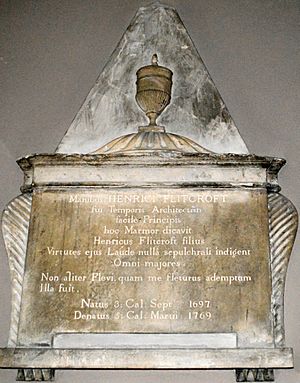Henry Flitcroft facts for kids
Quick facts for kids
Henry Flitcroft
|
|
|---|---|
| Born | 30 August 1697 probably Hampton Court, England
|
| Died | 25 February 1769 (aged 71) Hampstead, England
|
| Nationality | English |
| Occupation | Architect |
| Buildings | Wentworth Woodhouse Woburn Abbey St. Giles-in-the-fields |
Henry Flitcroft (born August 30, 1697 – died February 25, 1769) was an important English architect. He was a key figure in the second wave of Palladianism. This was a style of building inspired by the designs of the Italian architect Andrea Palladio, who lived in the 1500s. Palladian buildings often look grand and balanced, with features like columns and domes, similar to ancient Roman and Greek temples.
Henry came from a simple background. His father was a worker in the gardens at Hampton Court. Henry started his career as a joiner, which means he built things with wood. While working as a carpenter at Burlington House, he had an accident and broke his leg. During his recovery, a young nobleman named Lord Burlington noticed Henry's talent for drawing. By 1720, Henry became Lord Burlington's main assistant for architectural drawings. He helped with projects like designing a dormitory for Westminster School and overseeing construction at Tottenham House. Working closely with Lord Burlington, who was a leader in the new Palladian style, taught Henry a lot about architecture.
Contents
Becoming a Royal Architect
Henry Flitcroft helped prepare drawings for a book called The Designs of Mr. Inigo Jones. This book, published in 1727, showed the work of a famous English architect named Inigo Jones. Lord Burlington supported and supervised this project.
In May 1726, Lord Burlington helped Henry get a job at the Office of Works. This was a government department responsible for royal buildings. Henry worked his way up from Master Carpenter and Master Mason to Comptroller of the King's Works. This was a very important position in the world of architecture.
Henry also received special building jobs for members of the British Royal Family, such as the Duke of Cumberland. For the Duke, Henry worked at Windsor Great Park. He even helped create the large Virginia Water Lake there.
Busy Building Life
Henry Flitcroft was always busy with private projects for wealthy clients. Like many professional architects, he also built houses to sell in new areas of London. He would supply the stone and manage the construction of the buildings he designed.
Some parts of a room designed by Henry Flitcroft in the 1720s, from Potternewton Hall near Leeds, were later moved to Sutton Park in Yorkshire after 1935.
From 1746 to 1756, Henry was the Surveyor of the Fabric of St Paul's Cathedral. This meant he was in charge of maintaining and repairing the famous St Paul's Cathedral in London.
Family and Legacy
In 1724, Henry Flitcroft married Sarah Minns. His son, also named Henry, was born in Hampton in 1742. Henry Flitcroft is buried at St Mary with St Alban, Teddington. His son Henry (who died in 1826) and his wife Jane (who died in 1778) are buried with him.
The words on his tombstone say that he "had the honour of serving three first Princes of the House of Brunswick in the Board of Works." This means he worked for three kings from the Hanoverian royal family. He was a Clerk, then Master Mason, and finally Controller of the Board of Works until he died on February 25, 1769. Inside the church, there is also a special memorial to Henry Flitcroft.
A street in London, Flitcroft Street, near St Giles in the Fields, was named after him.
Famous Buildings and Projects
Henry Flitcroft designed or worked on many important buildings across England. Here are some of his major projects:
- Lilford Hall, Northamptonshire: In the 1740s, he designed the inside rooms.
- Bower House, Essex: Built in 1729.
- St Giles in the Fields, London: He designed this church between 1731 and 1734.
- Ditchley Park, Oxfordshire: From 1724 onwards, he designed the interiors, working well with another architect, William Kent.
- Wentworth Woodhouse, Yorkshire: Starting in 1735, he rebuilt and made the west side larger, adding new sections.
- St Giles House, Wimborne St Giles, Dorset: He designed the interiors between 1740 and 1744.
- Stowe House, Buckinghamshire: Around 1742, he is believed to have designed the State gallery.
- Wimpole Hall, Cambridgeshire: He worked on this house from 1742 to 1745.
- Stourhead, Wiltshire: From 1744 to 1765, he designed the beautiful temples in the gardens.
- Woburn Abbey, Bedfordshire: He worked on this grand building from 1748 to 1761.
- Milton Hall, Northamptonshire: He designed this between 1750 and 1751.
Henry Flitcroft also built many structures in the West End of London, a busy part of the city.
Images for kids
-
West front, Wentworth Woodhouse, the wings were altered later by John Carr














